|
市场调查报告书
商品编码
1651181
永续性平台市场:2025-2029年Sustainability Platforms Market Report 2025-2029 |
|||||||
本报告研究了永续发展平台市场,并提供了市场定义、成长动力和课题、市场规模趋势和预测、竞争格局、主要趋势和发展、案例研究等。
样品view
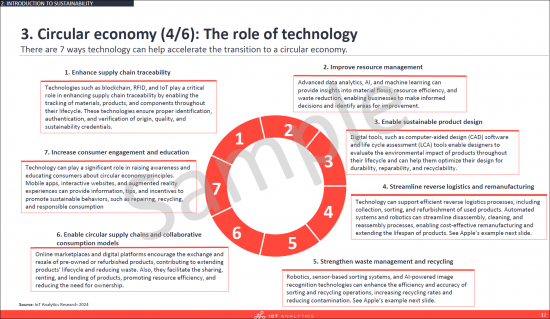
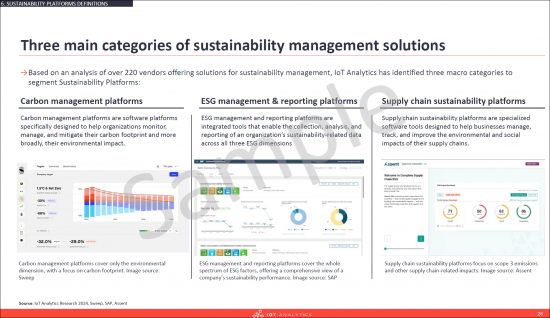
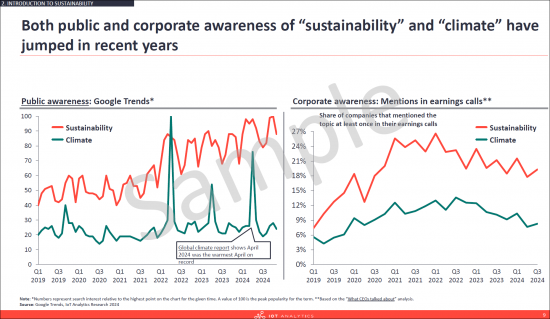
样品view
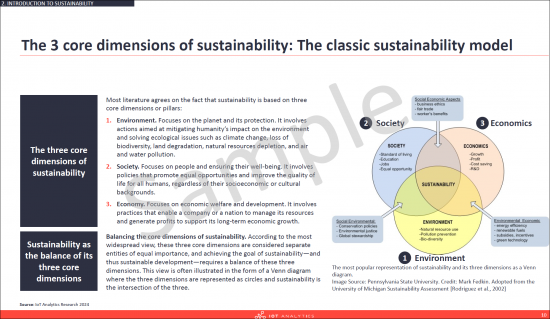
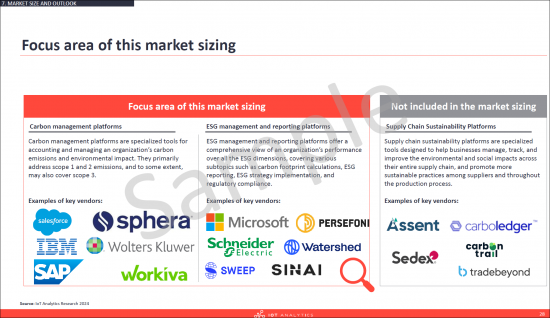
市场相关资料
永续发展平台市场仍处于发展初期,但正在快速成长。大多数采用仍处于试点阶段或小规模。市场高度分散,主要分为八大供应商类型。供应商分为八个部分:
|
|
样品view
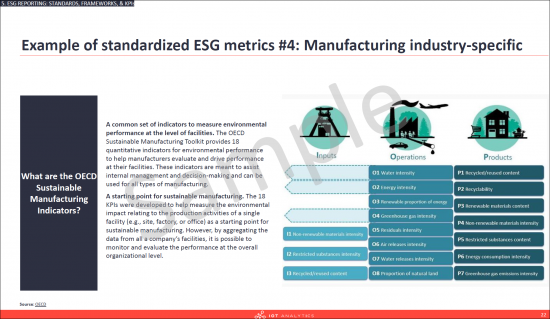
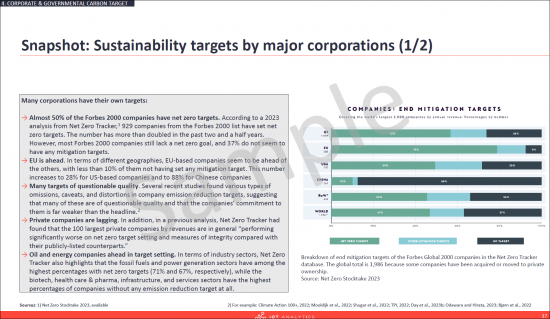
主要的市场的推动要素与课题·趋势
IoT Analytics,特别指定了5个促进因素和7个课题。
所谓永续性平台?
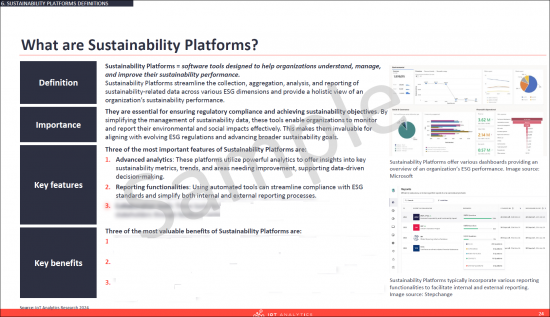
定义
永续发展平台是一种软体工具,旨在帮助组织了解、管理和提高其永续发展绩效。永续发展平台简化了跨各个 ESG 维度的永续发展相关数据的收集、汇总、分析和报告,提供了组织永续发展绩效的整体视图。
分类
|
|
|
样品view
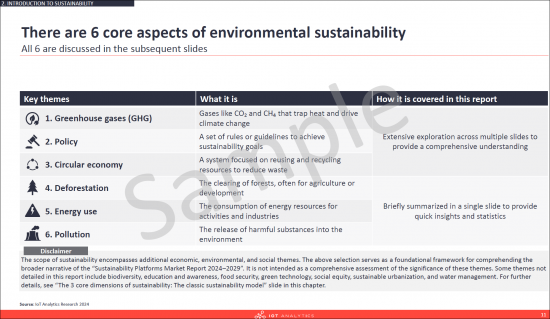
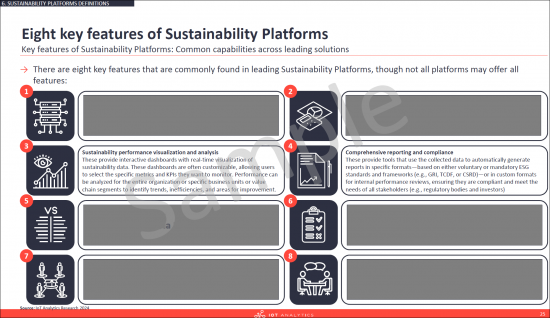
主要的特征
永续发展平台最重要的三个特征是:
- 1. 进阶分析:这些平台利用强大的分析功能深入了解关键的永续发展指标、趋势和改进领域,以支援数据驱动的决策。
- 2. 报表:自动化工具可以帮助您简化 ESG 标准的合规性并简化内部和外部报告流程。
- 3. 协作工具:这些工具透过回馈系统、共享仪表板和整合工作流程促进利害关係人之间的沟通和参与。
主要优点
永续发展平台最有价值的三个好处是:
- 1. 更容易遵守法规:自动化 ESG 资料管理和报告可以帮助公司满足不断变化的监管要求。
- 2. 改善决策:数据驱动的洞察力使企业能够识别风险和机遇,并推动优化资源使用和降低成本的策略。
- 3. 透明度和利害关係人参与:提供清晰易懂的资讯可以与利害关係人建立信任,展现负责任行事的承诺,并提高组织的声誉。
问题解答
- 什么是永续发展平台?
- 永续发展平台的主要特征和功能是什么?
- 领先的永续发展平台供应商有哪些?
- 永续发展平台市场的规模有多大以及如何细分(按地区和垂直产业)?
- 有哪些公司实施永续发展平台的案例研究?
- ESG报告如何运作?
- 政府和企业的永续发展目标是什么?
- 什么是永续性?
- 市场的主要推动因素和趋势是什么?
- 采用永续性管理平檯面临的主要课题是什么?
刊载企业
|
|
目录
第1章 摘要整理
第2章 永续性:简介
- 章概要·重要点
- 出发点:永续性是人类面临的最大课题
- 近年来,公众和企业对 "永续性" 和 "气候" 的认识不断提高。
- 1) 永续性的定义与 2) 永续发展
- 永续发展的三个核心:经典永续发展模型
- "更强大" 的永续发展模式将环境放在首位
- 全球永续发展努力发展的重要里程碑
- 环境永续性有六个主要维度
- 1.温室效应气体
- 2.政策:联合国的永续的开发目标
- 3.循环型经济
- 4.森林破坏
- 5.能源的使用
- 6.污染
- 提高永续性的方法:分析师的主要见解
第3章 与碳足迹管理
- 章概要·重要点
- 什么是碳足迹?
- 碳中和与净零之间的差异
- 碳足迹计算的三个温室气体排放范围
- 企业可以透过三种主要方式减少碳足迹
- 碳价
- 快照:全球碳定价工作的概述
- ETS 和碳税的范例
- 概览:当前 ETS 和碳税价格趋势
- 永续发展发展其他 10 个常用术语
第4章 企业和政府的二氧化碳排放目标
- 章概要·重要点
- 概述:主要国家政府的永续性目标
- 概述:主要城市的永续性目标
- 概述:大企业的永续性目标
- 案例1:Microsoft
- 案例2:Apple
- 案例3:Siemens
第5章 ESG汇报:标准,组成架构,KPI
- 章概要·重要点
- 环境、社会与治理报告及其三个构面
- ESG汇报所扮演的角色
- ESG与永续性的差异
- ESG资料的检验与保证
- ESG汇报的最佳业务实践
- 理解ESG标准和组成架构
- 4个主要的ESG标准化团体
- SBTi (The Science Based Targets initiative)
- ESG法规
- ESG法规:各地区概要
- ESG 报告的演变:强调全球标准的必要性
- ESG KPI:定义和作用
- 一般的ESG指标概要
- 环境指标:说明·一般的KPI
- 社群诗学:说明和一般的KPI
- 管治指标:说明和一般的KPI
- 标准化的ESG指标范例#1:相关利益者的资本主义指标
- 标准化的ESG指标范例#2:先进的製造业
- 标准化的ESG指标范例#3:行动产业
- 标准化的ESG指标范例#4:製造业
第6章 永续性平台定义
- 章概要·重要点
- 什么是永续发展平台?
- 永续发展平台的八个关键特征
- 永续发展管理解决方案主要有三大类
- 碳管理平台
- ESG 管理与报告平台
- 供应链永续发展平台
- 永续发展平台的 8 大主要优势
- 三种主要定价模式
第7章 市场规模与展望
- 章概要·重要点
- 这个市场规模的焦点领域
- 全球永续性平台市场转变·预测
- 永续性平台市场:厂商市场占有率
- 全球永续性平台市场:各地区
- 全球永续性平台市场:北美
- 全球永续性平台市场:欧洲
- 全球永续性平台市场:亚太地区
- 全球永续性平台市场:南美
- 全球永续性平台市场:中东·非洲
- 全球永续性平台市场:俄罗斯·CIS
- 全球永续性平台市场:最大的国家
- 全球永续性平台市场:各业界
- 全球永续性平台市场:客户各规模
- 全球永续性平台市场:软体各类型
第8章 竞争情形
- 章概要·重要点
- 业者情势:解决方案的各焦点
- 业者情势:企业的重点各领域
- 业者情势:企业的所在地
- 业者情势:不同企业规模
- 过去3年的SP企业的值得注意的收购
- 业者情势:Start-Ups
- 最受到了资金提供的SPStart-Ups
- 企业简介:概要
- 业者简介:Microsoft
- 业者简介:SAP
- 业者简介:Salesforce
- 业者简介:IBM
- 业者简介:Sphera
- 业者简介:Persefoni
- 业者简介:Wolters Kluwer
- 业者简介:Workiva
- 业者简介:Watershed
- 业者简介:Sweep
- 业者简介:ServiceNow
- 业者简介:Cority
- 业者简介:Schneider Electric
- 业者简介:Siemens
第9章 促进因素,课题,趋势
- 章概要·重要点
- 促进因素
- 课题
- 趋势
第10章 调查手法
第11章关于 IoT Analytics
A 219-page report on the market for sustainability software platforms for both carbon (footprint) management and ESG reporting (incl. market sizing, competitive landscape and key trends)
The "Sustainability Platforms Market Report 2025-2029" is part of IoT Analytics' ongoing coverage of emerging technology topics and vertical applications. The information presented in this report is based on the results of multiple surveys, secondary research as well as qualitative research, i.e., interviews with industry experts from vendors and end users. The document includes definitions for sustainability platforms, market projections, adoption drivers, competitive landscape, key trends and developments, and case studies.
SAMPLE VIEW



The main purpose of this document is to help our readers understand the current sustainability platform landscape by defining, sizing, and analyzing the market.
SAMPLE VIEW


About the market
The sustainability platform market is still at an early stage of development but growing rapidly. Most adopters are still at the pilot stage and/or with small-scale implementations. It is highly fragmented with eight main vendor types. Vendors are categorized into 8 segments:
|
|
SAMPLE VIEW


Key market drivers, challenges, and trends
IoT Analytics identified 5 drivers and 7 challenges highlighted in the report.
What are sustainability platforms?

Definition
Sustainability Platforms are software tools designed to help organizations understand, manage, and improve their sustainability performance. Sustainability Platforms streamline the collection, aggregation, analysis, and reporting of sustainability-related data across various ESG dimensions and provide a holistic view of an organization's sustainability performance.
Categorization
|
|
|
SAMPLE VIEW


Key features
Three of the most important features of Sustainability Platforms are:
- 1. Advanced analytics: These platforms utilize powerful analytics to offer insights into key sustainability metrics, trends, and areas needing improvement, supporting data-driven decision-making.
- 2. Reporting functionalities: Using automated tools can streamline compliance with ESG standards and simplify both internal and external reporting processes.
- 3. Collaboration tools: These tools facilitate communication and engagement among stakeholders through feedback systems, shared dashboards, and integrated workflows.
Key benefits
Three of the most valuable benefits of Sustainability Platforms are:
- 1. Easier regulatory compliance: Automating ESG data management and reporting ensures organizations stay aligned with evolving regulatory requirements.
- 2. Improved decision-making: Data-driven insights enable organizations to identify risks and opportunities, driving strategies that optimize resource use and reduce costs.
- 3. Transparency and stakeholder engagement: Providing clear, accessible information builds trust with stakeholders and demonstrates a commitment to responsible practices, enhancing an organization's reputation.
Questions answered:
- What are sustainability platforms (i.e., a definition)?
- What are the key features and capabilities of sustainability platforms, both for ESG reporting and for carbon management?
- Who are the leading vendors of sustainability platforms, and how much market share do they have?
- How large is the sustainability platforms market, and how does it split into segments (i.e., by regions or industries)?
- What are some insightful case studies of companies implementing sustainability platforms?
- How does ESG reporting work?
- What are some of the sustainability targets of governments and selected corporations?
- What is sustainability, and what are its various aspects?
- What are the key drivers and trends in the market?
- What are the key challenges to sustainability management platform adoption?
Companies mentioned:
A selection of companies mentioned in the report.
|
|
Table of Contents
1. Executive Summary
2. Introduction to sustainability
- Introduction to sustainability: Chapter overview and key takeaways
- Starting point: Becoming sustainable is a top challenge for humanity
- Both public and corporate awareness of "sustainability" and "climate" have jumped in recent years
- Defining 1) sustainability and 2) sustainable development
- The 3 core dimensions of sustainability: The classic sustainability model
- The "stronger" sustainability model puts the environment first
- Key milestones in the evolution of global sustainable development efforts
- There are 6 core aspects of environmental sustainability
- 1. Greenhouse gases: Overview
- 1. Greenhouse gases: What they are
- 1. Greenhouse gases: The nine main types of gases
- 1. Greenhouse gases: Main contributors to GHG emissions
- 1. Greenhouse gases: Emissions by sector
- 1. Greenhouse gases: Fossil fuel company emissions
- 1. Greenhouse gases: The Greenhouse effect
- 1. Greenhouse gases: The effect on climate change
- 2. Policy: The UN Sustainable Development Goals
- 2. Policy: The UN Sustainable Development - goals
- 2. Policy: The UN Sustainable Development - current progress
- 2. Policy: The Paris Agreement - overview
- 2. Policy: The Paris Agreement - current status
- 3. Circular economy: Overview
- 3. Circular economy: Key benefits
- 3. Circular economy: Key challenges
- 3. Circular economy: The role of technology
- 3. Circular economy: Daisy helps Apple battle e-waste
- 3. Circular economy: Life cycle assessment
- 4. Deforestation
- 5. Energy use
- 6. Pollution
- How to become more sustainable: Key analyst viewpoints
3. Carbon footprint and management
- Carbon footprint and management: Chapter overview and key takeaways
- What is a carbon footprint?
- The difference between Carbon Neutral and Net Zero
- Three GHG emission scopes for carbon footprint calculations
- Three main ways for companies to reduce their carbon footprint
- Carbon pricing
- Snapshot: Overview of carbon pricing initiatives around the world
- Practical examples of ETS and carbon taxes
- Snapshot: Current ETS and Carbon Taxes pricing trends
- Ten other common sustainable development terms
4. Corporate and governmental carbon footprint targets
- Corporate and governmental carbon footprint targets: Chapter overview and key takeaways
- Snapshot: Sustainability targets by major governments
- Snapshot: Sustainability targets by major cities
- Snapshot: Sustainability targets by major corporations
- Example 1: Microsoft's commitment to sustainability
- Example 1: Microsoft's mission to become carbon negative by 2030
- Example 2: Apple's commitment to sustainability
- Example 2: Apple 2030-Apple's journey to carbon neutrality by 2030
- Example 3: Siemens' commitment to sustainability
5. ESG reporting: Standards, frameworks, KPIs
- ESG reporting - Standards, frameworks, & KPIs: Chapter overview and key takeaways
- Environment, social, and governance reporting and its three dimensions
- The role of ESG reporting
- The difference between ESG and sustainability
- ESG data verification and assurance
- Best practices for ESG reporting
- Understanding ESG standards and frameworks
- There are currently 4 major ESG standards organizations
- These are the four most commonly used ESG frameworks
- The Science Based Targets initiative (SBTi)
- ESG regulations
- ESG regulations: Regional overview
- Deep Dive: Two key ESG reporting regulations in EU and US
- The evolution of ESG reporting highlights the need for global standards
- ESG KPIs: Definition and role
- Overview of common ESG metrics
- Environmental metrics: Description and common KPIs
- Social metrics: Description and common KPIs
- Governance metrics: Description and common KPIs
- Example of standardized ESG metrics #1 : Stakeholder capitalism metrics
- Example of standardized ESG metrics #2: Advanced manufacturing-specific
- Example of standardized ESG metrics #3: Mobile industry-specific
- Example of standardized ESG metrics #4: Manufacturing industry-specific
6. Sustainability platforms definition
- Sustainability Platforms definitions & segmentation: Chapter overview and key takeaways
- What are Sustainability Platforms?
- Eight key features of Sustainability Platforms
- Three main categories of sustainability management solutions
- Carbon management platforms
- ESG management and reporting platforms
- Supply chain sustainability platforms
- Eight key benefits of Sustainability Platforms
- Three main pricing models
7. Market size and outlook
- Introduction: Chapter overview and key takeaways
- Focus area of this market sizing
- Global Sustainability Platforms Market 2022-2029
- Sustainability Platform market: Vendor shares 2023
- Global Sustainability Platform market: By region
- Global Sustainability Platform market: North America
- Global Sustainability Platform market: Europe
- Global Sustainability Platform market: Asia-Pacific
- Global Sustainability Platform market: Latin America
- Global Sustainability Platform market: Middle East & Africa
- Global Sustainability Platform market: Russia & CIS
- Global Sustainability Platform market: Largest countries
- Global Sustainability Platform market: By industry
- Global Sustainability Platform market: By customer size
- Global Sustainability Platform market: By software type
8. Competitive landscape
- Introduction: Chapter overview and key takeaways
- Vendor landscape: By solution focus
- Vendor landscape: By company focus
- Vendor landscape: By company location
- Vendor landscape: By company size
- Noticeable acquisitions of SP companies in the past 3 years
- Vendor landscape: Start-ups
- Most funded SP start-ups
- Company Profiles: Overview
- Vendor profile: Microsoft
- Vendor Profile: SAP
- Vendor Profile: Salesforce
- Vendor Profile: IBM
- Vendor Profile: Sphera
- Vendor Profile: Persefoni
- Vendor Profile: Wolters Kluwer
- Vendor Profile: Workiva
- Vendor Profile: Watershed
- Vendor Profile: Sweep
- Vendor Profile: ServiceNow
- Vendor Profile: Cority
- Vendor Profile: Schneider Electric
- Vendor Profile: Siemens
9. Drivers, challenges and trends
- Introduction: Chapter overview and key takeaways
- Drivers: Overview
- Drivers
- Challenges: Overview
- Challenges
- Trends and developments: Overview
- Trends and developments








